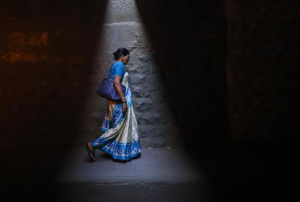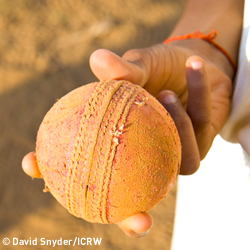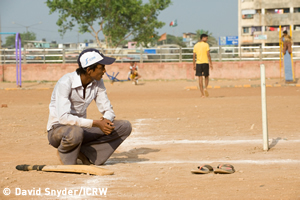The setting: Mumbai, India

In 2011, India was rated as one of the most dangerous places to be woman (Source: http://www.trust.org/spotlight/The-worlds-most-dangerous-countries-for-women-2011/))
This is an area of the world where parents favor their daughters marriage over their education, men believe they have a right to abuse their wives, husbands dictate the appearance of their wives and daughters (hair length, makeup, clothing, etc.), brothers feel that their sisters hold all responsibility for household chores, and sexual harassment of women on the street is almost become a past time for young men and boys.
In 2011, India was rated as one of the most dangerous places to be a woman. According to a video produced by the International Center for Research on Women (ICRW), 1 in every 3 married female youth experienced physical, sexual, and emotional violence. 19% of young men have sexually abused a girl in school, and 87% of young men believes that it is always women to be blamed for all sexual violence against them.
The hardest part to swallow: men in Mumbai see this behavior as a form of respect to women. They feel that they are protecting the women by safe-guarding them from all potential harm. Views and traditions such as this are almost impossible to reverse, as they are ingrained in the culture and embedded institutionally in the structures of the society.
In 2000, Futures without Violence developed Coaching Boys Into Men (CBIM) with the initiative:
“to engage coaches as positive role models and train them to deliver message to their male athletes about the importance of respecting women and understanding that violence never equals strength.” Parivartan was the brainchild of this initiative, born from ICRW.
Parivartan is a unique program that uses cricket to teach young men that aggressive behavior does not make them “real men.” The ultimate aim of the program is to reduce violence against women, and help boys and men view women and girls are equals. In Hindi translation, it means change, or transition from childhood to adulthood.
The implementation of any international development program is the tipping point on the scale of effectiveness. Planning and follow-up are important as well, but proper implementation is absolutely key.
In this case, ICRW implemented the program in partnership with Mumbai Schools Sports Association (MSSA), an organization Apnalaya, and Breakthrough, with financial support from the Nike Foundation. Cricket was chosen to be used as the agent for change because of its widespread popularity in India and predominance as a male sport. According to a program leader, it is important to establish something that is appealing to young men, and sports fits that criteria very well.
There were two divisions of the program: a community based division and a slum-based division. 26 coaches and their teams agreed to participate in the community program, where most of the schools were private with middle to upper socioeconomic status. The slum division composed of 16 total teams, comprised of low socioeconomic participants. Spanning different communities, the program was assessed comparatively across these differences, and uniformly across the power of sport to inflict social change in all circumstances.
The mentors were young male cricket coaches, who are highly respected by young boys and men in India. Using mentors that can relate and garner respect from the audience is a key part in implementing a program. According to one of the players, “Coach is everything.. We will do anything for him…”. Clearly, you can see how coaches are much more than just instructors, but more like role models for athletes. Feroz Moideen, a representative from the Family Violence Prevention Fund, says that Parivartan is the,
“first extensive evaluation to highlight the role that coaches can play in the off-the-field lives of their athletes.”
It was important that the mentors and leaders were willing to talk about issues of violence towards women with transparency and honesty, without feeling embarrassed in front of other men (as most Indians might).
The effectiveness of the program was assessed by measuring “changes in perceptions, attitudes and behaviors related to gender equity and violence against women and girls among athletes exposed to the program.”
All mentors were given a kit with a card series, reference handbook, and a diary. The cards included discussion topics about respect, behaviors toward women, insulting language, etc. Planned group sessions on a weekly basis were the basis for intervention, and involved discussion, games, and films and supplementary materials such as posters, pamphlets, and brochures. The mentors were trained for the process, and received training throughout as well.
From 2008 to 2012, Parivartan was implemented in the two divisions in Mumbai. The general goals were:
- Raise awareness about abusive and disrespectful behavior
- Promote gender-equitable, non-violent attitudes
- Teach skills to speak up and intervene when witnessing harmful and disrespectful behaviors
A summary report of the program, Engaging Coaches and Athletes in Fostering Gender Equality: Findings from the Parivartan Program in Mumbia, India was published in May 2012 by ICRW and Futures without Violence.
Data collection:
Athletes completed a survey at baseline and at follow-up (1 year later), which examined attitudes towards “gender stereotypes and roles, boys’ control over girls’ behavior, and violence against girls as well as violence based behaviors.” Coaches and mentors both completed a survey at baseline and at followup (1 year later) about attitudes toward gender stereotypes, men’s control of their wives’ behavior, and justification of wife beating,” according to the final report. Six in depth interviews and two focus group sessions were held as follow up as well. Female relatives of coaches and mentors were interviewed to document perceived changes in the coaches’ or mentors’ gender-related attitudes and behavior
Findings indicate positive changes in both the mentors/coaches, and athletes involved in the program. Results show that “training and ongoing support can equip coaches and mentors to deliver an innovative program to young male athletes which can improve the athletes’ gender related attitudes and behaviors”. The program can also inflict positive change on the attitudes and behaviors of the coaches/mentors involved as well.
The findings are very encouraging, yet in order to have a sustained impact, a continued investment in the program and effort needs to be institutionalized in the existing structures and reinforced throughout multiple channels of communication.
Action inspires Action.
The Parivartan program spurred a mobile interactive campaign to further promote the same ideals. This campaign uses sports amongst other tools such as dance and trivia to educate youth on how to stop and prevent disrespect of women.
Furthermore, Parivartan Plus will build on the same principles established in the goals of Parivartan and include girls, tackle issues of sexuality and the AIDS epidemic, as well as sustenance on alcohol and drugs.


